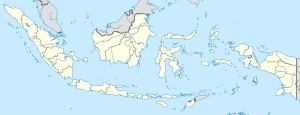Pematang Siantar
| Pematang Siantar | |
|---|---|

|
|
| Basic data | |
| State : | Indonesia |
| Province : | North Sumatra |
| Coordinates : | 2 ° 58 ' N , 99 ° 4' E |
| Residents : | 236,893 (2011) |
| Area : | 79.97 km² |
| Official Website: | http://www.pematangsiantar.go.id |
| politics | |
| mayor | Hulman Sitorus |
Pematang Siantar on the map of Indonesia |
Pematang Siantar (also: Pematangsiantar ) is an independent city (Kota) in the province of North Sumatra on the Indonesian island of Sumatra . The branched off railway connection to the provincial capital Medan, which is just 130 km to the north, ends in the town to the northeast of Lake Toba . Pematang Siantar is an agricultural trading center for rice , tea , tobacco and oil palms , from which the polymers rubber and synthetic fibers are produced and traded. During the colonial period, the city developed into the second largest on the island after Medan. The population is about 236,000.
history
Until the arrival of the Dutch in 1907, rule over the settlement was in the hands of the Damanik , a tribe of the Simalungun ethnic group . With Tuan Sangnawaluh Damanik they had their last king. Pematang Siantar then fell under colonial administration and remained there until 1942 when Japan annexed the area. By 1915, the settlement area had grown into a town with 3700 inhabitants. From this point on, the city grew considerably, because it was located at a favorable interface between the plantation lands and the Batak highlands. In 1945 - with the end of the Second World War - the city became independent and received an autonomous status.
population
The city and its surroundings are the settlement area of the Simalungun-Batak, one of several Batak people groups (such as the Angkola, Mandailing, Toba, Pakpak, and Karo Batak). Today there are also Chinese , Achinese , ethnic Malays , Minangkabau , as well as resettled Javanese , but also Sikh , Arabs and Tamils .
Transport and tourism
The starting point for the growth in trade and later for tourism was the development of the transport infrastructure, based on the construction of the railway. It was founded in 1883 as the first private railway company ( Deli Spoorweg Maatschappij ) and was under the administration of the Dutch until 1957. After that it was nationalized. This infrastructural advantage is used today by tourism. In addition, the Trans-Sumatra Highway , which connects the city directly, is also important.
Siantar BSA motorcycles (Becak) are used as public transport in Pematang . Since there is no spare parts supply, most of them are very individually and lovingly modified and repaired.
Pematang Siantar is already in the Batak area and is therefore of increased cultural interest. The goods of the Batak, such as the Ulos, are sold at the local market . Not far are the cities of Berastagi and Kabanjahe , the latter seat of the government of the Karo administrative district , behind which are the Sinabung volcano and Lake Toba, regions that are frequently visited.
Personalities
- Wiecher Zwanenburg (* 1933 in Pematang Siantar), Dutch Romance scholar and linguist
Remarks
- ↑ Pematangsiantar at enzyklo.de, accessed on January 9, 2011.
- ↑ Page no longer available , search in web archives: Badan Pusat Statistics
- ↑ Ursel Wolfram-Seifert, Factors of Urbanization and the Development of Regional City Systems in Sumatra: Analysis of Settlement Structures in the Provinces of North, West and South Sumatra (Indonesia)
- ↑ Janianton Damanik, Labor Market Policy Implications of Tourism Development in Developing Countries // The Example of North Sumatra , Indonesia
- ↑ Photo by TrekEarth
literature
- Wilhelm Volz, Royal Prussian Academy of Sciences in Berlin, Volume 1: Die Batakländer. Humboldt Foundation, D. Reimer (E. Vohsen), 1909
- Wolfgang Clauss, Economic and social change among the Simalungun Batak of North Sumatra, Breitenbach, 1982 - 265 pages, ISBN 3-8815-6230-3
- Tribus Vol. 55-57, Stuttgart (Germany). Museum for regional and ethnology, Society for Earth and Ethnology eV, Stuttgart, Stuttgart (Germany). Linden Museum for Ethnology, 2006, Linden Museum Stuttgart
Pictures of the indigenous people (Simalungun-Batak)
2/3 is a selection of historical pictures (provided by the Tropenmuseum Amsterdam , Netherlands)
Garment ( Ulos ) of the Simalungun







